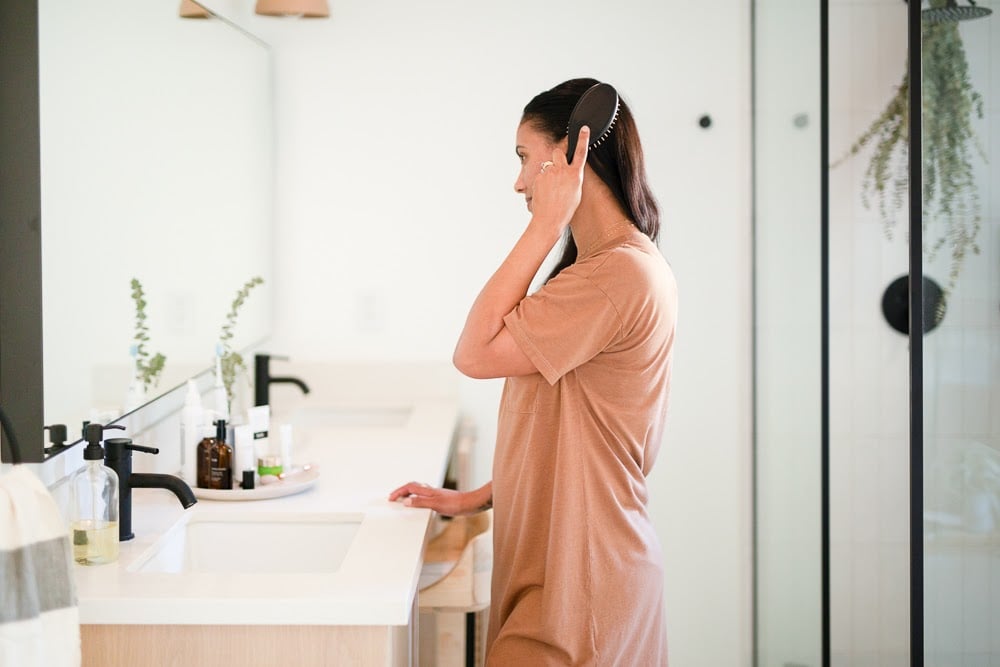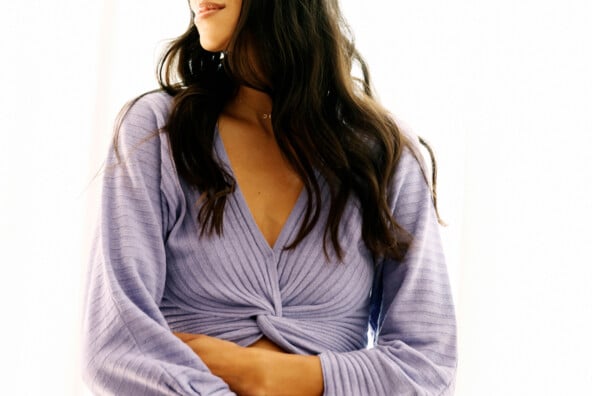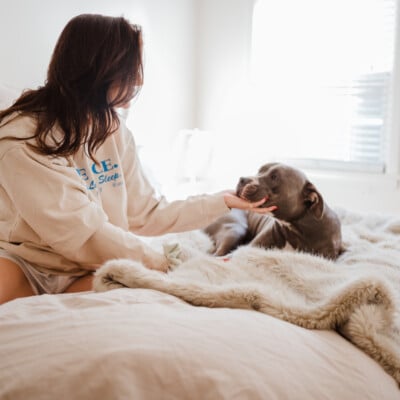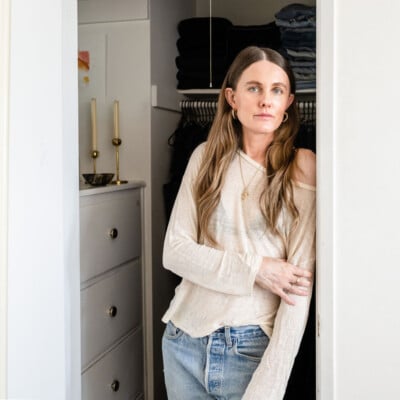It all began on a walk to our local coffee shop. I weaved my fingers through my hair, gently pulling my curly strands into a loose ponytail. My hands emerged with an unprecedented clump of hair. I was shocked and horrified. From that moment forward, for the next seven months, I dreaded combing my hair, shampooing my hair, or gazing at my pillowcase in the morning. Like many postpartum experiences, I wasn’t prepared, whatsoever, for the devastation of postpartum hair loss. Thankfully, I quickly learned that there are plenty of postpartum hair loss treatments.
And even more importantly, I learned that postpartum hair loss is commonplace. Other moms, both friends in real life and strangers on the internet, coalesced. We agonized over our relentless shedding, another aspect of postpartum that deserves a soliloquy. Particularly universal, roughly 40-50% of new moms experience postpartum hair loss. Among the many postpartum changes that occur, hair loss is at the top of the list. Thankfully, there are a variety of postpartum hair loss treatments for this temporary phenomenon.
Hair Growth During Pregnancy
Before we talk about postpartum hair, let’s take a moment to honor those luscious pregnancy (or pre-pregnancy) locks. Miss them? Me too. Rest assured, the cyclical nature of hair growth and loss is normal. Throughout our lives, our hair transitions across three phases:
- Anagen phase (growing phase): This can last from two to eight years. This phase generally refers to about 85 to 90 percent of the hair on your head.
- Catagen phase (transition phase): This qualifies the time that hair follicles shrink. It takes about two to three weeks.
- Telogen phase (resting phase): This takes about two to four months. At the end of this phase, the hair falls out.
During pregnancy, increased numbers of hair follicles remain in the anagen phase for longer periods. This is due to hormonal changes. Specifically, higher levels of estrogen prolong the growth phase. This results in less shedding. Some women also notice other changes: Their hair becomes shinier or changes texture, i.e. curly to wavy.
What Causes Postpartum Hair Loss?
After giving birth, estrogen falls. This is typically when women enter the telogen phase. This, in turn, can cause noticeable hair loss. Luckily, dermatologists don’t consider this true hair loss. Instead, it’s a temporary condition caused by falling estrogen levels. Although excessive hair shedding (otherwise known as postpartum telogen effluvium) may seem permanent, it’s temporary. Most women see their hair return to its normal fullness by the time their baby turns 15 months. Others regain normal fullness even earlier. That said, if you’re currently in the thick of postpartum hair loss woes, take a deep breath. There are a variety of postpartum hair loss treatments to try.

When Does Postpartum Hair Loss Start?
This varies from woman to woman. However, postpartum hair loss can start any day after your baby arrives, peaking around the 4-month mark. If your baby is a few weeks old and you’re losing clumps of hair, no need to panic. You’re in the telogen phase. Before you know it, you’ll return to the anagen phase, regaining your normal hair growth. Patience is key. Postpartum hair loss can be devastating—of course—but most women notice a gratifying return of their hair within 12 months of shedding. If you notice consistent shedding after 15 months postpartum, you may want to seek professional advice from a board-certified dermatologist. He or she can suggest postpartum hair loss treatments as well.
Breastfeeding And Postpartum Hair Loss
What’s the correlation between breastfeeding and postpartum hair loss? Essentially, none. During pregnancy and one year after birth, researchers monitored changes in women’s hair cycles. They found that at four months postpartum, breastfeeding women had higher amounts of hair in the growth phase than women who were not breastfeeding. However, this difference was short-lived. The average number of growth phase hairs vs. resting phase hairs showed no significant difference between the breastfeeding vs. non-breastfeeding groups.
Can Postpartum Hair Loss Be Prevented?
Because postpartum hair loss is a normal result of hormonal changes, it’s not something you can immediately stop. However, there are habits you can instill to minimize the effects of postpartum hair loss. In turn, hopefully promoting healthy hair growth.
In the weeks and months following delivery, ensure you are getting gentle-to-moderate exercise (once cleared from your doctor), incorporate lifestyle-centric stress support strategies (therapy or meditation), consume a healthy diet, rich in nutrients to support healthy hair, and be consistent with postpartum vitamins or supplements. Furthermore, take gentle care of your hair. While your follicles are in the telogen phase, they are in their most fragile state. To avoid additional shedding, be gentle while brushing, washing, and drying. When possible, avoid tight hairstyles, as they place too much traction on follicles. To make things even easier, get a haircut before your baby arrives. Prevention tips are equally as important as postpartum hair treatments.

10 Postpartum Hair Treatments To Try
While you wait for your hair to return to its normal growth cycle, here are 10 postpartum hair treatments to try.
Opt for a silk pillowcase.
Another way to be kind to your hair, swap your cotton pillowcase for silk. It can help make sure your hair isn’t pulled in your sleep. Plus, sleeping with a silk pillowcase is beneficial for your skin too. Win-win.
Consider adding Nutrafol Postpartum to your routine.
This supplement was developed with an OBGYN, using whole-food-sourced ingredients traditionally used for lactation. This blend of clinically-tested ingredients was chosen to support all aspects of pregnancy recovery. Everything from nutrient depletion, physical exhaustion, and emotional stress can lead to thinning hair in postpartum women. It was also formulated to fill the nutritional gaps between prenatal and postnatal needs. Lastly, it’s breastfeeding-friendly, compatible with most prenatals and multivitamins and can be taken immediately after birth to support whole-body and hair health recovery.
Try Prose’s Root Source hair growth supplement.
Using concentrated brewer’s yeast and a complex of B vitamins (including biotin), Root Source supports hair growth with a proprietary blend of ingredients. It also contains clinically-proven millet, wheat, and coriander to stimulate hair growth at the bulb of the follicle, while thickening collagen to anchor and secure the hair.
Choose a high quality hair oil for massaging into your scalp.
Coconut, almond, castor, or olive oil are all wonderful postpartum hair treatments. Use lukewarm oil to massage the scalp at least one to two times a week. Follow it up by wrapping a wet hot towel on your head for five minutes. Shampoo your hair, thereafter.
Speaking of shampoo, Oribe’s Gold Lust Repair & Restore Shampoo is worth a shot.
Although more expensive than traditional shampoos, the quality is unparalleled. This sulfate-free shampoo is one of the best out there, particularly when it comes to postpartum hair loss. In fact, it was created with specific hair growth compounds to tackle the problem of thinning, weakened hair. The shampoo improves the microcirculation scalp, boosts its oxygen consumption, and stimulates the hair follicles to grow. It is perfectly safe for new mothers as it does not contain parabens, alcohols, hormones, or harsh chemicals. With regular use, this shampoo can reduce postpartum and age-related hair loss.
Another shampoo to try: Innersense’s Hydrating Cream Hairbath.
This product works to boost hydration and nourish hair from the inside out. Essential oils, like sage and tamanu, help balance oil for a healthy scalp while nourishing elements soften and smooth the cuticle. Deeply hydrating yet lightweight, this silicone-free formula leaves hair bouncy and healthy.
In need of both a shampoo and conditioner? Vegamour’s GRO Revitalizing Shampoo and Conditioner Kit is the answer.
Enhanced with Karmatin™ (the first-of-its-kind vegan keratin), this clean, color-safe duo was made to bring you your shiniest, healthiest hair yet. Truly far from ordinary, GRO Revitalizing Shampoo and Conditioner bonds to hair follicles and remains attached to strands even after rinsing, making these nourishing formulas the world’s first chemical-free keratin hair treatment products. Otherwise, check out their shampoo. It works wonders.
For a night of self-care, check out Ouai’s Thick Hair hair mask.
Great for postpartum mamas, this mask restores hydration, repairs damage, and adds shine to thick hair. Made with almond, macadamia, and olive oils, as well as shea butter and hydrolyzed keratin, use this mask once per week to nourish your postpartum scalp. For a more economical option, try this incredible hair mask (the reviews speak for themselves!).
Vegamour’s GRO Hair Serum is an effective way to promote sustainable hair health.
We love a good serum. Safe for everyday use, this plant-based, multi-tasking serum uses a combination of clinically-tested ingredients to soothe the scalp and revitalize hair roots. Free of toxic chemicals, carcinogens or harmful side effects, this cruelty-free, vegan hair serum is formulated to increase the appearance of hair density while reducing signs of shedding. The results? Thicker, fuller-looking postpartum hair.
Less of a treatment and more of a must-have, the Tangle Teezer needs a permanent spot in your shower.
A cult classic loved by everyone, this detangling wet (or dry) hair brush glides through the hair with no pulling. It leaves hair super smooth and tangle-free—super helpful when experiencing postpartum hair loss.






